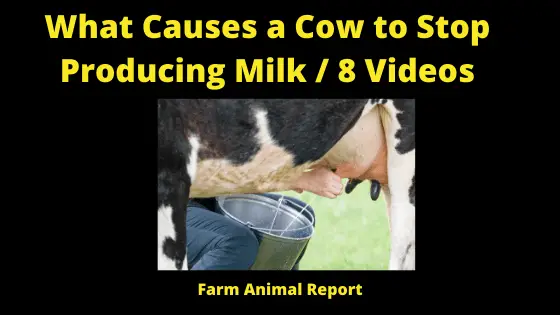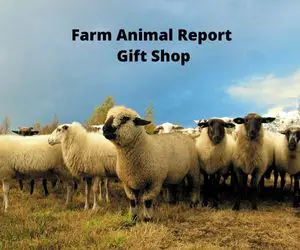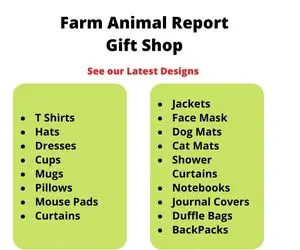What Causes a Cow to Stop Producing Milk
Do you know what causes a cow to stop producing milk? There are many reasons why a cow might stop giving milk, but the most common one is the lack of food. When cows don’t get enough to eat, they stop producing milk. Other reasons that cows might stop giving milk include stress, illness, and poor living conditions. If you want your cow to keep producing milk, you need to make sure she is well-fed and comfortable!
Reasons Cows Stop Producing Milk / 14 Reasons
- Cows Age
- Infertility
- Failure to expel afterbirth
- Infection of Uterus
- Luteal cysts
- Mastitis
- Milk Fever
- Lameness
- Heat Stress
- Poor Body Condition
- Overcrowding
- Food Nutrients lacking
- Poor Feed amounts
- Sudden Feed Changes
- Metritis
- Mycotoxins in feeds
What Causes a Cow to Stop Producing Milk – The dairy cow produces large amounts of milk in its lifetime. Production levels peak at around 40 to 60 days after calving. Production declines steadily afterward until milking is stopped at about 10 months.
The cow is “dried off” for about sixty days before calving again. Within a 12 to 14-month inter-calving cycle, the milking period is about 305 days or 10 months long. Among many variables, certain breeds produce more milk than others within a range of around 6,800 to 17,000 kg (15,000 to 37,500 lb.) of milk per year.
The Holstein Friesian is the main breed of dairy cattle, is having the “world’s highest” productivity, at 10,000 L of milk per year. The average for a single dairy cow in the US in 2007 was 9,164 kg (20,204 lb.) per year, excluding milk consumed by her calves. High production cows are more difficult to breed at a two-year interval.
Many farms take the view that 24 or even 36-month cycles are more appropriate for this type of cow. Dairy cows may continue to be economically productive for many lactation cycles. In theory longevity of 10 lactations is possible.
See Our Guide – Ways to Make Money Cattle Farming
The chances of problems arising which may lead to a cow being culled are high, however;
the average herd life of US Holstein is today fewer than 3 lactations. This requires more herd replacements to be reared or purchased. Over 90% of all cows are slaughtered for 4 main reasons:
Reasons Cows are Removed from Dairy Production
Infertility;
Failure to conceive and reduced milk production. Cows are at their most fertile between 60 and 80 days after calving. Cows remaining “open” (not with calf) after this period become increasingly difficult to breed, which may be due to poor health. Failure to expel the afterbirth from a previous pregnancy, luteal cysts, or metritis, an infection of the uterus, are common causes of infertility.
Mastitis;
a persistent and potentially fatal mammary gland infection, leading to high somatic cell counts and loss of production. Mastitis is recognized by reddening and swelling of the infected quarter of the udder and the presence of whitish clots or pus in the milk.
Treatment is possible with long-acting antibiotics but milk from such cows is not marketable until drug residues have left the cow’s system, also called withdrawal period.
Lameness;
persistent foot infection or leg problems causing infertility and loss of production. High feed levels of highly digestible carbohydrates cause acidic conditions in the cow’s rumen.
This leads to laminitis and subsequent lameness, leaving the cow vulnerable to other foot infections and problems which may be exacerbated by standing in feces or water-soaked areas.
Production;
Some animals fail to produce economic levels of milk to justify their feed costs. Production below 12 to 15 L of milk per day is not economically viable
Cow longevity is strongly correlated with production levels. Lower production cows live longer than high production cows, but maybe less profitable.
Cows no longer wanted for milk production are sent to slaughter.
Their meat is of relatively low value and is generally used for processed meat. Another factor affecting milk production is the stress the cow is faced with.
Other Factors of Decrease Milk Production
Increased average days in milk:
As dairy cows enter mid to later lactation; milk production naturally trails off with milk production peaking during early lactation.
As the percentage of cows in mid to later lactation increases (increasing days in milk), milk production will be expected to be lower. This contributing factor to lower milk production might seem very obvious, but can provide a possible explanation or partial explanation which can easily be overlooked.
Longer-term effects of heat stress:
With the average day time temperatures in the 90’s this past July and August for long periods of time and with hot nights, dairy cows were definitely under heat stress.
Although fan, sprinklers, and other ways to accomplish heat abatement are important and need to be used to decrease the effects of heat stress, the heat and humidity still had a detrimental effect on feed intake and fertility. Often times, these detrimental effects on fertility and milk production are seen for 6 to 8 weeks after heat and humidity subside.
Lower body condition of early lactation cows:
In early lactation, dairy cows cannot consume adequate amounts of energy to meet the energy needs for milk production and maintenance of the cow herself.
As a result, early lactation cows are said to be in negative energy balance and rely on body stores of fat or adipose tissue to support the additional amounts of energy needed to support milk production they cannot consume. If these stores are not present or are mobilized too quickly, cows often times will produce the amount of milk equal to the amount of energy they can consume.
In other words, they will not milk as well as they could have or peak as high in milk production. Thin early lactation cows often are related to cows calving thinner than normal or metabolic disorders related to the transition back into the milking herd that results in cows going off feed and dropping in body condition quickly.
OverCrowding / More cows in the milking herd:
Often-times cows are added to the milking string to improve cash flow without making accommodations for increased bunk and/or resting space.
Overcrowding at the feed bunk can decrease feed intake especially in fresh and early lactating cows resulting in lower milk production. Sometimes overcrowding with other contributing causes can result in lowered milk production even when it appears that no feeding and management practices have changed.
Thinner cows at calving:
Dairy cows are the most efficient and cost-effective at putting on body condition or fat stores when they are milking versus when they are dry.
Thus, our management programs are geared toward putting a condition on cows in mid to later lactation, having them in the proper condition at dry off, and maintaining that condition during the dry period. Summer temperatures can decrease or stop the growth of pasture grasses and legumes, thus decreasing forage availability and sometimes dry cows lose weight or body condition if alternative forages are not provided.
In addition, with higher grain costs, dry cows may not have been provided adequate amounts of grain to maintain body condition if forage quality was low. Dry cows that calve too thin will not have the energy reserves to milk well this next lactation, especially during early lactation.
Rebalanced rations to reflect the quality of forages currently being fed:
The quality and thus nutrient content of forages change between crop year, cuttings, and type of forage. In addition, yearly differences exist in the digestibility of forages by the rumen bacteria.
These changes in NDF digestibility can greatly affect the amount of energy cows and, more importantly, bacteria receive from the forages and other feeds consumed. A current forage analysis should be used to balance rations numerous times each year.
Monthly ration balancing or review of rations being fed is recommended for the most economical and efficient use of forage resources. With the wide swings in commodity prices, this reevaluation becomes even more critical.
The limited grain in corn silage: Produce – Dry
With this summer’s drought and high temperatures during corn pollination, corn silage may contain limited amounts of grain and the amount of corn silage available to be fed may be limiting.
These changes in the quality and quantity of corn silage potentially decrease the amount of energy coming from these forages. To try and compensate for the decreases seen in grain content, more energy needs to be added to these rations in the form of ground corn grain or other byproducts, increasing the cost to feed the milking herd.
At the same time, these alterations may alter the digestibility of starch and fiber fractions of the diet and the bacteria may not have the identical types and digestibility of energy sources compared to diets containing higher grain, corn silage diets.
Bottom line, when the bacteria do not get adequate amounts of energy at specific times, they produce fewer end products cows can use to make milk, and, as a result, milk production may be reduced. Sometimes, these diets need to be tweaked overtime to get the best combination.
Working with your nutritionist and fine-tuning these diets over time is the best way to achieve the desired results. Blending last year’s corn silage with this year’s has helped cows adjust to the differences and bridge the gaps. This may offer one explanation of why some herds have been able to hold milk production similar to previous years.
Changes in forages being fed:
With reduced corn silage yields and multiple dry years, some dairy farmers have opted to include silage made from forage sorghum into diets for the milking herd.
Granted these varieties most likely have higher digestibility than older varieties of forage sorghum, but they still contain less energy than higher-yielding, energy-dense corn silage. Can they work well in rations for milking cows?
Yes, but your nutritionist needs to make sure the bacteria have the nutrients they need (carbohydrates and nitrogen or amino acid source) at the correct time. Thus, old recipes for grain mixes may not always work and they may or may not support 70-80 lb. herd averages.
Problems when transitioning cows back into the milking herd:
A smooth transition of cows back into the milking herd is critical to getting dairy cows to milk well in early lactation and rebreeding. Often-times, minimizing stress, caused by limited feed bunk space (recommend 36 inches per cow), cow comfort (provide effective heat abatement), and resting space, 3 weeks before calving through 3 weeks after calving, is the starting point.
Diets need to contain adequate amounts of effective fiber or chew factor for proper rumen fill, minerals and vitamins to prevent subclinically (no visible signs but blood calcium is low) milk fever, and adequate but not excessive amounts of energy and protein.
Subclinical problems are often not detected and can cause issues in fresh cows that result in decreased feed intake before or after calving, rapid losses in body condition, and decreased milk production and reproductive performance.
Other disease issues:
Clinical cases of diseases, such as mastitis or metritis, can decrease milk production and reproductive efficiency. In addition, mycotoxins in feeds (forages as well as grains) also can decrease feed intake in herds and may affect performance.
However, before dairy farmers blame mycotoxins for decreases seen in milk production and/or reproductive performance, other aspects of their feeding and management program should be examined and eliminated as potential causes first.
Conclusion
There are many challenges that can lead to a cow stopping milk Production. This will give you a place to start. We suggest getting a Food Nutritionist to formulated a diet for your best dairy production. It will help to have the healthiest Dairy Cows, and consequently the best Milk.
Cattle Losses 2010
| Cause of Death | Percentage of Total |
|---|---|
| Respiratory Problems | 26% |
| Unknown Reasons | 18% |
| Digestive Problems | 13% |
| Birth Problems/Calving | 12% |
| Weather | 12% |
| Diseases | 5% |
| Lameness | 4% |
| Coyotes | 3% |
| Mastitis | 2% |
| Metabolic Problems | 2% |
| Carnivores | .9% |
| Poisoning | .9% |
| Domestic Dogs | .6% |
| Large Cats | .5% |
| Theft | .4% |
| Vultures | .3% |
| Wolves | .2% |
| Bears | .1% |
World Cattle Breeder Associations
| Cattle Association | Location | Link |
|---|---|---|
| National Cattleman's Beef Associations | United States | NCBA |
| United States Cattlemans Association | United States | USCA |
| Ohio Cattlemans Association | Ohio | OCA |
| American Angus Association | United States | AAA |
| United Kingdom Cattle Associations | UK | UKCA |
| Australia Cattle Associations | Australia | ACA |
When to start Milking a cow after Calving
The answer to this question depends on several factors, including whether or not the cow has been vaccinated for neospora caninum and whether she has had any previous calves that were infected with the disease. Neospora caninum is a parasitic disease that can be transmitted from mother cows to their calves via contaminated colostrum (the first milk produced after calving). If you are unsure whether or not your cow has been vaccinated, please consult your veterinarian before starting the milking process.
In general, it is safe to start milking 12 hours after calving if the cow has been vaccinated and 24 hours if she has not been vaccinated. However, please note that these are general guidelines; if you have any concerns, please consult your veterinarian before proceeding with milking.
How to Start Milking a Cow After Calving
Many farmers choose to milk their cows by hand during the calving process. This is a personal choice, and there are benefits and drawbacks to both hand-milking and using a machine. If you do choose to hand-milk, there are a few things you should know about the process.
How to Hand-Milk a Cow After Calving
You will need the following supplies: clean pails, clean strips of cloth, clean towels, and a clean bucket. It is important that everything you use is clean in order to avoid introducing bacteria into the cow’s udder.
1. Wash your hands thoroughly with soap and water.
2. Spray the cow’s udder with a disinfectant solution.
3. Place a strip of cloth around the base of each teat.
4. Grasp the teat with your thumb and forefinger and squeeze gently until milk starts flowing.
5. Wipe the teat off with a clean towel after each milking.
6. Repeat steps 4 and 5 until the pail is full.
7. Pour the milk into a clean bucket and place it in a cool location until you are ready to refrigerate it.
8. Repeat steps 1-7 for each cow you need to milk.





